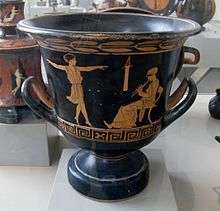Painter of the Berlin Dancing Girl

The painter's name vase
The Painter of the Berlin Dancing Girl was an Apulian red-figure vase painter who was active between 430–410 BC. He was named after a calyx krater in the collection of the Antikensammlung Berlin[1] which depicts a girl dancing to the aulos played by a seated woman.
As one of the first South Italian red-figure painters, he must have been educated in an Attic workshop. His name vase shows influences from the work of the Phiale Painter who worked in Attica. He and his followers most likely had their workshops in Taras, which is Taranto today.[1]
Works
Other works attributed to him include:
- A krater located in the Rhode Island School of Design Museum. A Centauromachy is shown on the vase with Theseus or Herakles battling two centaurs.
- An amphora in the Museo Provinciale Sigismondo Castromediano in Lecce, Italy. It depicts Briseis and Achilles.
- The sole column crater attributed to this painter is in the collection of the Museo Camillo Leone in Vercelli, Italy. It shows the pursuit of Troilus by Achilles and is dated to 420–410 BC.[2]
- A pelike in the National Gallery of Victoria showing an Amazonomachy scene.
References
- 1 2 Robertson, Martin (1992). The Art of Vase-Painting in Classical Athens. Cambridge, England: Cambridge University Press. p. 236. ISBN 978-0-521-33881-3.
- ↑ Cambitoglou, Alexander; Harari, Maurizio (1997). The Italiote red-figure vases in the Museo Camillo Leone at Vercelli. Rome: Brettschneider. pp. 19–20. ISBN 978-88-7062-964-4.
Further reading
- Cambitoglou, Alexander (1988). "Troilos pursued by Achilles". In Betts, J. H.; Hooker, J. T.; Green, J. R. Studies in Honour of T.B.L. Webster. 2. Bristol: Classical Press. pp. 1–22. ISBN 978-0-86292-194-1.
- Trendall, Arthur Dale; Cambitoglou, Alexander (1978). The Red-Figured Vases of Apulia. Volume 1: Early and Middle Apulian. Oxford, England: Clarendon Press. ISBN 978-0-19-813218-9.
External links
| Wikimedia Commons has media related to Berlin Dancing Girl Painter. |
This article is issued from
Wikipedia.
The text is licensed under Creative Commons - Attribution - Sharealike.
Additional terms may apply for the media files.